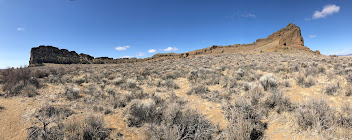Wandering in the Rain Shadow
Walking through a misty
moss-covered forest feels as comfortable to me as relaxing with a good book in
my favorite chair at home. Having lived my entire life on the west side of the
Cascades, I feel a deep familiarity with nature as it expresses itself in moist
verdancy. But now and then I long for the stark beauty and openness of Oregon’s
desert country. Without lush growth cloaking this arid landscape, its unique
geology is plainly visible. The land of little rain can hide no secrets: a
treeless habitat allows observers to witness the intimate details of life in
the desert.
Driving along a high desert road, I round a bend and am confronted with the unexpected
immensity of Fort Rock. It rises above the sagebrush flats like a volcanic
version of the Roman Colosseum. Waves from an ancient lake breached the porous
lava and ash of the rocky rim’s south wall, creating an amphitheater filled
with water. The lake dried up about 13,000 years ago, leaving a curving rampart
towering 300 feet above the dusty lakebed.
The trail leaves the small parking lot and winds through a jumble of dark boulders fallen from the looming wall above. Bright orange crusts decorate the rocks. Called elegant sunburst lichens, they look like orange peels flattened on the hard surfaces. A lichen is not a single organism, but a partnership between a fungus and an alga. The alga photosynthesizes to provide food for itself and the fungus, while the fungus provides a protective structure to the alga. Scientists have recently discovered that, in some lichen species, a third organism joins the partnership: a yeast. It benefits the coalition by providing chemicals to ward off harmful microbes. This taxonomy-crossing alliance has enabled lichens to inhabit some of Earth’s harshest habitats for millions of years. Gently rubbing my finger over the sunburst lichen’s dry surface, I marvel at its ability to survive while patiently waiting for the desert’s next meager offering of rain.
Naturalists use sunburst
lichens as clues in the search for small mammals and birds. The pumpkin-colored
growths thrive on rocks coated with nitrogen from animal droppings. When I see
patches of bright orange on rocky slopes high in the Cascades, I know marmots
or pikas reside there. If I see a sunburst colony growing at the base of a rock
wall, I immediately look up for long-established raptor nests on the cliff
above. The scattered pattern of brilliant lichens here at Fort Rock indicates
the location of sentry posts where chipmunks or ground squirrels survey their
territory. Wanting to catch a glimpse of the resident nitrogen-providers, I
settle on a flat rock and scan my surroundings. The breeze brings the musky
spice of sagebrush; a crow calls in the distance. After several minutes a
six-inch blur of fur darts across the path with its tiny tail held straight up
in the air: the telltale sign of a least chipmunk. It pops up on a boulder,
showing multiple dark stripes streaking the gray fur on its back and face.
These little imps thrive in dry country where they forage in the sagebrush for
seeds, buds, insects and bird eggs. They escape extreme desert temperatures,
both hot and cold, by sheltering under the rocks.
Leaving my little friend behind, I climb to the top of a volcanic bench cut by long-vanished waves at the foot of the striated rock wall. A succession of steamy eruptions formed these layers of porous lava, gooey ash and boiled lakebed mud. The trail parallels the horseshoe shape of the curving wall. Stunted juniper trees dot the shrubland. Suddenly, a four-foot sagebrush quivers with the buzzy trill of a Brewer’s Sparrow: zreeee – zrrr – zrrr – zrrr. I watch the drab little bird, perfectly camouflaged in muted desert colors, as it searches for insects under the bushes. Its very survival hinges on the presence of sagebrush, where it eats, sleeps and nests.
After curling around to the west side of the amphitheater, the trail rises to a terrace above its open end. From this vantage point I see the entire volcanic ring and the vast sagebrush sea stretching for miles to the south. Motion catches my eye. Lifting my binoculars, I focus on a coyote about 300 yards away. It trots along at an intentional pace, looking as though it has important business to conduct. For the coyote, like all creatures out here, the business of survival is a continuous pursuit. Carrying its tail down in typical coyote fashion, it zig-zags through the sagebrush, a puff of dust trailing each footfall. Soon it leaves my range of sight and I lower my binoculars.
Hiking back on the stretch of trail that
closes the looping route, I think about how each component in this desert
ecosystem connects to everything around it. The fallen rocks create shelter for
the tiny least chipmunk, whose nitrogen-rich droppings nourish the growth of
bright lichens. Those same droppings may contain sagebrush seeds that grow to
provide nesting sites for the Brewer’s Sparrow. The hungry chipmunk may take
eggs from the sparrow’s nest or it may become a one-bite meal for the coyote.
The coyote’s presence benefits the sparrow by limiting the chipmunk population.
Coyote – chipmunk – sparrow – sagebrush – lichen - rock: all are part of a
complex ecological network. Oregon’s desert country may seem open but it is
never simple. Its rich complexity draws me back again and again.


.jpg)





No comments:
Post a Comment